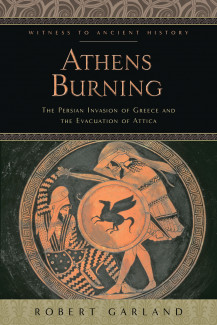
Johns Hopkins UniversityEst. 1876
America’s First Research University
Behind the book: Athens Burning

My history with Athens Burning goes back 40 years to when I was doing research for my Ph.D. on Greek burial customs. Athens’ main cemetery, called the Cerameicus or 
But to do that I needed to research the events that led to the building of that wall – and the materials that were used for it. So I decided to take the story back to the time when the Athenian civilian population decided to evacuate Attica, leaving the Persians a free hand to burn their city down, which they did not once but twice. I found the story of the Athenians abandoning their city twice and returning to find it in ruins twice immensely moving.
So the whole project grew out of my interest in how death and burial were dealt with in the ancient world – and how the Athenians, when they wanted to protect themselves against an event of this kind in the future didn’t hesitate to use the broken monuments and anything else of stone they could lay their hands on to build a wall around their city.
But there’s another strand to why I wrote the book. I’m deeply interested in the plight of refugees, and whenever I get interested in something I like to take my interest back to antiquity and see whether antiquity can shed any light on the subject. And it always does. Two years ago I wrote a book called Wandering Greeks: The Greek Diaspora from the Time of Homer to the Death of Alexander the Great, which covered the plight of those on the move over a vast sweep of time and sought to demonstrate how human movement was a perpetual phenomenon in the Greek world. But then I wanted to look at an example in detail, so that is when I came up with the idea of The Burning of Athens, because there isn’t really any other example of a refugee crisis that we can look at in comparable detail, and even though there are lots of gaps in our evidence we can still build a fascinating picture of Athenian society uprooted.
So The Burning of Athens is, I believe, both topical and in a sense necessary – a reminder that the terrible challenges that refugees face today have always been a part of the human story, even for an advanced and highly sophisticated society like that of Athens.
Robert Garland is the Roy D. and Margaret B. Wooster Professor of the Classics at Colgate University. He is the author of Wandering Greeks: The Ancient Greek Diaspora from the Age of Homer to the Death of Alexander the Great and The Eye of the Beholder: Deformity and Disability in the Graeco-Roman World. His latest book, Athens Burning: The Persian Invasion of Greece and the Evacuation of Attica is available now.


